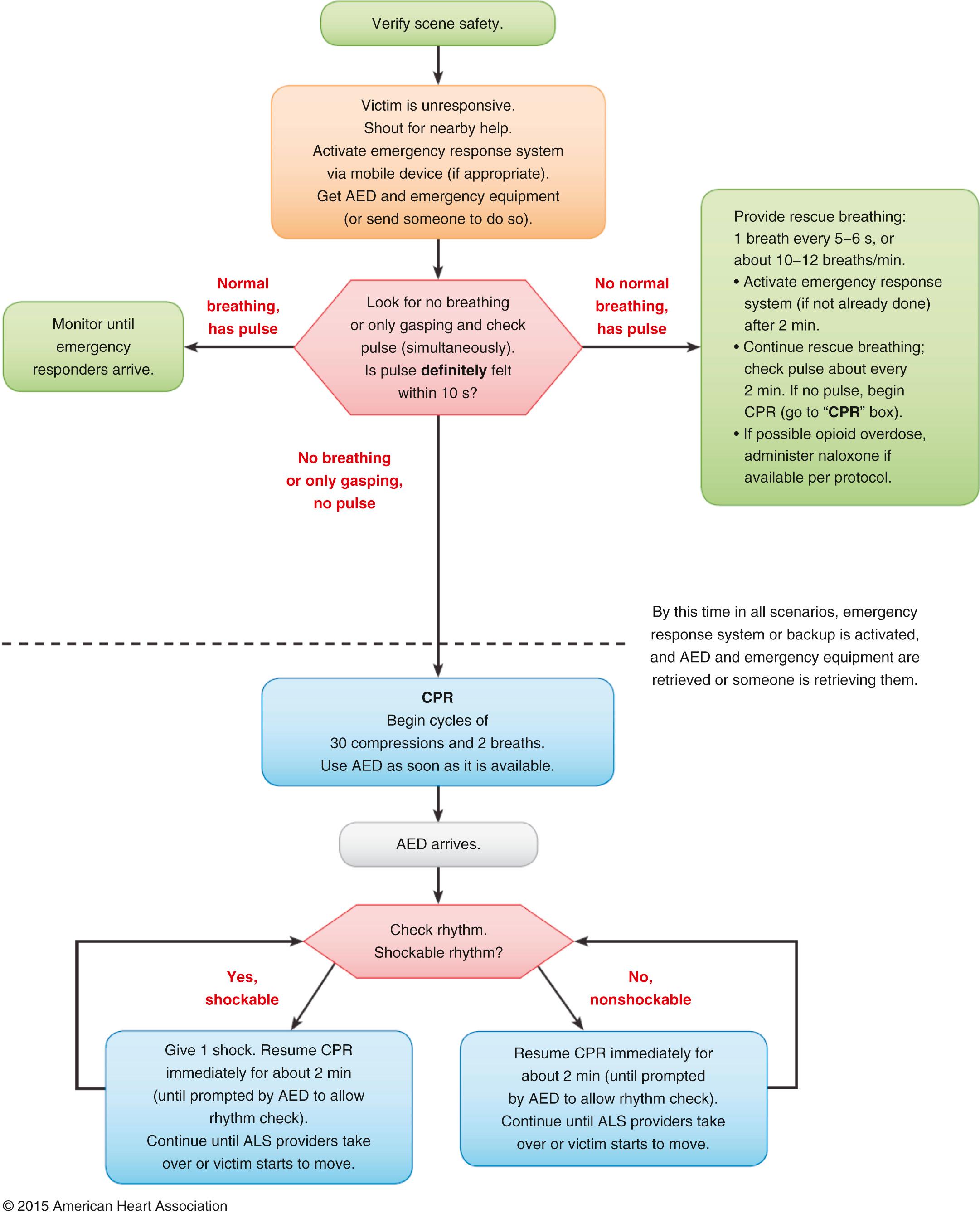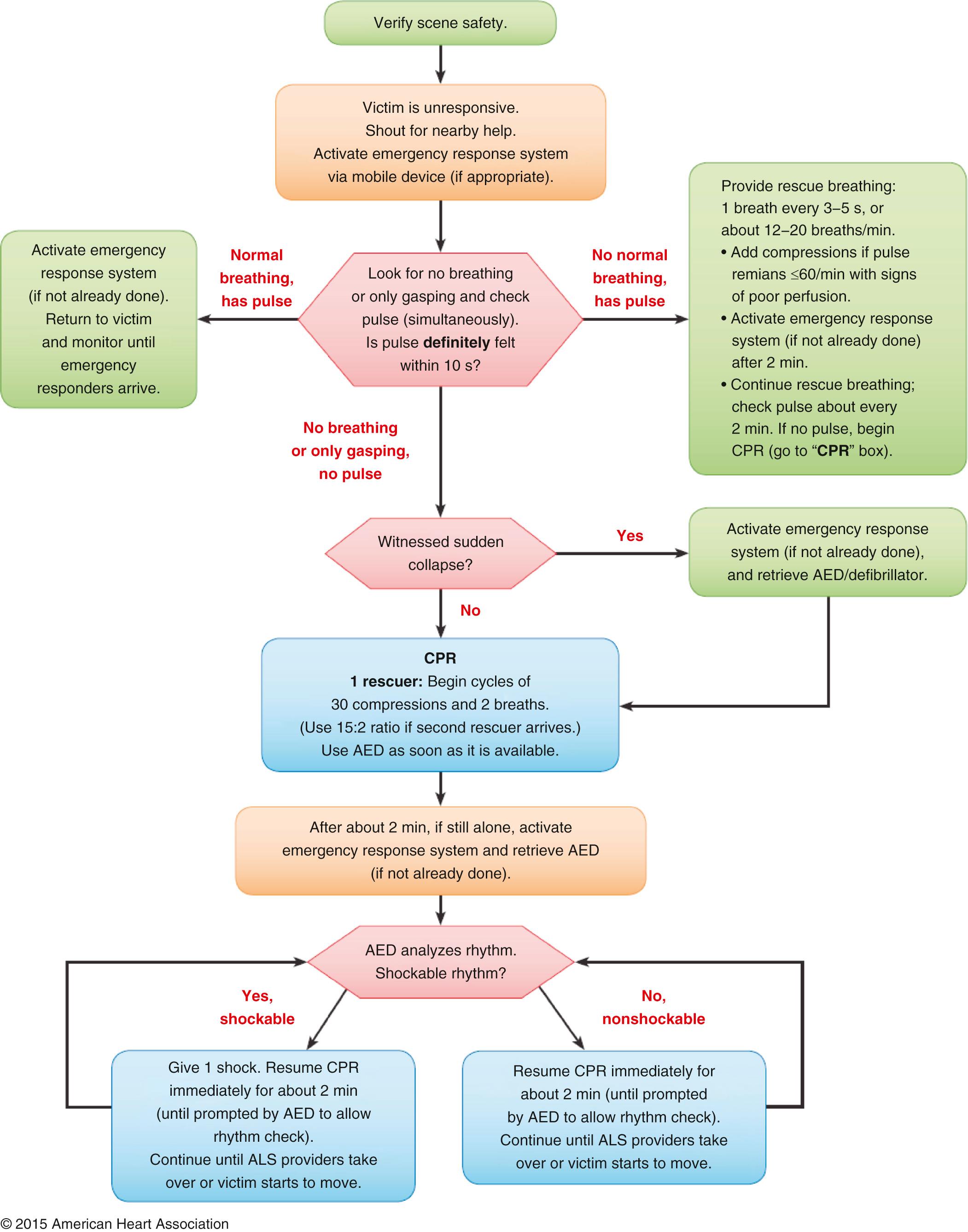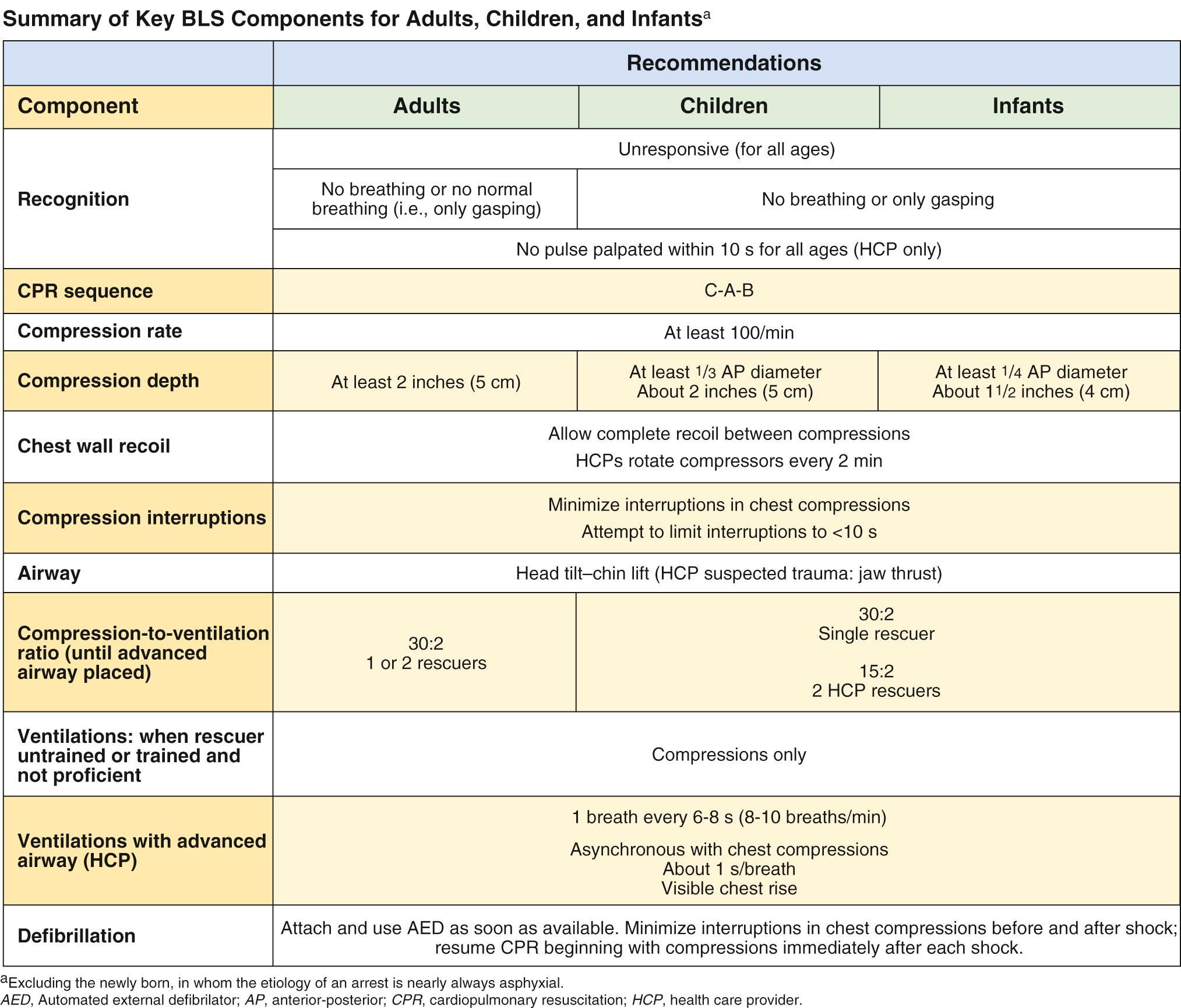Physical Address
304 North Cardinal St.
Dorchester Center, MA 02124
The objective of this chapter is to provide a practical approach to acutely ill and injured patients. The emphasis is on a prioritized assessment and diagnostic considerations, not on therapy. The chapter is for those who provide care in traditional health care environments such as clinics, doctors’ offices, and hospitals as well as those potentially caring for patients outside of traditional medical settings, or perhaps acting as a Good Samaritan helping someone in need while they are not at work.
In the assessment of acutely ill and injured patients, time can be a critical factor. Developing an organized, structured approach to rapidly assess the critically ill and injured patient is important to beginning the correct lifesaving therapies and identifying the proper resources and environment to take ideal care of the patient.
In contrast to the assessment of stable patients, the evaluation of acutely ill patients involves the rapid, systematic identification of pathophysiologic abnormalities that may require the initiation of lifesaving therapies while the final diagnosis is under investigation. Many causes of acute illness may have overlapping signs and symptoms that require investigation to discover the root cause, but therapy must begin to prevent further harm or death to the patient.
In the evaluation of acutely ill patients, it is always helpful to ask yourself, “What is the most serious threat to life, and have I begun to stabilize it as much as possible?” followed by asking, “Have I summoned the resources that I will likely need to care for this patient?” and then “What is the most likely cause, and what have I ruled out so far?”
When providing care in the field, it is also important to quickly assess the situation to determine what further resources may be needed to ideally care for the patient(s). Summoning additional resources in a timely fashion can sometimes make the difference between life and death. Identifying the situation of the patient at the scene may help determine the mechanisms of injury to assist in the diagnostic workup and in treatment for the patient.
No discussion of caring for the acutely ill and injured would be complete without a reminder to health care providers to look out for their own personal safety and wellness as an initial priority. Protection of oneself from pathogen exposure as well as trauma or additional injury is of paramount importance.
In caring for an acutely ill patient there are high risks for exposure to body fluids and exposure to communicable diseases. When caring for the patient with an altered mental status, the initial responder needs to take precautions in case the patient becomes aggressive or violent. In the case of the injured patient, the initial care provider needs to ensure that the scene is safe to begin to care for the patient to avoid harm to the care provider.
Standard precautions should always be taken to minimize the possibility for contamination and exposure. The potential for concern should be evaluated to determine the appropriate level of precautions needed. Wearing protective gloves is certainly considered a minimum step, but as the potential for contamination escalates, consideration should be given to masks with eye shields, protective gowns, respiratory masks, and so on, which are appropriate for the situation.
The safety of the care environment should always be a primary consideration. Having adequate police, security, or additional personnel to ensure that the environment is safe for the health care providers is paramount. Although this is especially true in the prehospital care environment, it must also be thought about in the hospital.
As you approach the apparent patient, always perform a brief evaluation to determine whether you are in a safe environment; if not, protect yourself and your patient to limit exposure to possible injury before providing care. Assess environmental hazards; the potential of agitation from a delirious patient, causing aggressive action; and other personnel hazards such as family members and bystanders.
While uncommon, if the situation exists in which it is likely that the rescuer(s) could be injured or killed while rendering care, the rescuer should wait until the situation can be made safe. For example, in an automobile accident, a patient trapped in a car in a busy traffic lane should not be given first aid until safety flares or cones can be placed to prevent secondary accidents. Other hazards, such as downed power lines, should be investigated as well. In an active shooter situation, care of the injured cannot begin until the scene has been appropriately secured by police personnel.
The initial task for the health care provider in approaching most, if not all, patients in acute situations involving an unconscious patient is to first ascertain that they are not in cardiopulmonary arrest. If so, summoning help and performing cardiopulmonary resuscitation (CPR) are the initial priorities. If the patient is not in need of CPR, immediate identification of the causes of their nonresponsiveness should be initiated through an organized two-step approach to the rapid patient assessment, which includes a primary survey and secondary survey . When caring for the acutely ill out of the traditional care environment, particular attention should be paid to the primary survey. This organized approach helps ensure that the major threats to life are identified first. The acceptable approach to these acute, undefined encounters is to consider the patient unstable until you can confirm, through a series of diagnostic steps, that the patient is well enough for you to take the time to perform a more rigorous and complete physical examination and document a complete history.
For the unconscious patient who is determined to be in cardiac arrest, the health care provider should initiate CPR according to the guidelines set by the American Heart Association (AHA). Cardiac arrest survival is directly related to how fast high-quality chest compressions (CPR) are started, along with defibrillation by an automatic external defibrillator (AED) as early as possible.
Chest compressions provide blood flow to the heart and brain during a cardiac arrest, and research has shown that delays or interruptions to compressions reduced survival rates. Additional research demonstrates increased survival from cardiac arrest correlating with the onset of defibrillation, if appropriate. Starting CPR with chest compressions can effectively circulate blood to the victim's brain and heart sooner, with the principal goal of maintaining some amount of oxygenated blood circulating through the brain.
Initiating ventilations are less critical, as victims will have oxygen remaining in their lungs and bloodstream for the first few minutes after a cardiac arrest.
Fig. 26.1 shows the AHA CPR overview for adults. Fig. 26.2 shows the AHA CPR overview for children.


Current guidelines of the AHA make recommendations based on if the lay rescuer is trained in CPR or not. According to the 2015 AHA Guidelines, 1
1 https://www.sca-aware.org/sites/default/files/comparison_chart_2015_aha_guidelines_for_cpr_and_ecc.pdf . Accessed February 25, 2019.
the sole lay rescuer trained in CPR should do four basic things:
Ensure Scene Safety
Call for Help
Start and Continue Compression-Only CPR
Send second person to find an AED
On the other hand, when a patient is in cardiac arrest and there are two or more rescuers who are trained in CPR (and/or working in the health care environment), add rescue breathing and aggressive use of an AED via a second rescuer/team of rescuers in this sequence:
Ensure Scene Safety
Call for Help/Activate Resuscitation Team
Apply AED as soon as available
Start 2 Rescuer CPR using a ratio of 30 Chest Compressions to Two Rescue Breaths
In the early days of CPR, an original A-B-C (airway, breathing, circulation) sequence was taught. However, it was later realized that survival rates improved with early chest compressions. Chest compressions were often delayed while the responder opened the airway to give mouth-to-mouth breaths or retrieved a barrier device or other ventilation equipment. Since 2010, the AHA Guidelines have recommended an overall change in the mnemonic to C-A-B . By changing the sequence to C-A-B, chest compressions can be initiated sooner, and ventilation delayed only minimally until completion of the first cycle of chest compressions (30 compressions should be accomplished in approximately 18 seconds).
C ompressions: Push hard and fast on the center of the victim's chest.
A irway: Tilt the victim's head back and lift the chin to open the airway.
B reathing: Give rescue breaths.
Because of the time sensitivity associated with interrupted blood flow to the brain and vital organs, it is safest to suspect cardiac arrest in any patient who is not obviously interacting with his or her environment. Performing a quick rapid assessment can oftentimes easily rule out cardiac arrest.
As you approach the patient, observe the scene and surrounding for potentials hazards. Then observe the patient closely, looking for spontaneous breathing or movements. If these are not discernible, stimulate the patient by talking loudly to him or her and gently shaking them while asking, “Are you okay?”
If there is no response or evidence of spontaneous breathing, call for help in any way you can without leaving the patient; it is unlikely that you can manage the entire resuscitation by yourself. If another person is available, have them locate the nearest AED.
Determine whether there is spontaneous cardiac function by feeling for a carotid pulse for 10 seconds or, in an infant, by palpating the arm for a brachial artery impulse. If there is no pulse, begin external chest compressions, at least 100 per minute.
To open an unconscious victim's airway, hyperextend the head and lift the patient's chin; place one hand on the patient's forehead and the other behind the patient's occiput, and tilt his or her head backward. This maneuver moves the tongue away from the back of the throat, allowing air to pass around the tongue and into the trachea. Caution should be exercised with any patient who has a suspected neck injury such as someone in a serious car crash. With such a patient, try to open the airway by lifting the chin and jaw without tilting the head backward; grasp the lower teeth and pull the mandible forward. If necessary, tilt the head back very slightly. If a patient is wearing dentures, remove them only if they occlude the airway.
If unresponsive: No breathing or no normal breathing (only gasping)
Try to get the person to respond; if they don't, roll the person on his or her back.
Call for 911 or ask others to do so. Get the AED if available and return to the victim.
If second rescuer is available, send them to get help and the AED.
Attach and use AED as soon as available.
Start chest compressions. Place the heel of your hand on the center of the victim's chest. Put your other hand on top of the first with your fingers interlaced.
Push chest at least 2 inches, 30 times in the center of the chest.
Push two-handed, with one hand on top of the other.
Push at a rate of at least 100 compressions per minute.
Allow complete chest recoil after each push.
Limit interruptions in chest compressions to less than 10 seconds.
Open the victim's airway.
Head Tilt–Chin Lift: tilt the head back and lift the chin.
Pinch closed the nose of the victim.
Take a normal breath and cover the victim's mouth with your own to create an airtight seal, and then give two 1 second breaths.
The victim's chest should rise with each breath.
Use barrier device if available.
Continue compressions and breaths—30 compressions, 2 breaths—until help arrives.
CPR ratio for CPR is 30 compressions to 2 breaths.
In two-person CPR, the rescuers should change positions after every 2 minutes to avoid fatigue and a deterioration in the chest compression quality.
Attach and use AED as soon as available.
Fig. 26.3 is a summary of these key basic life support components for adults, children, and infants (excluding newborn infants).

There is continued emphasis on providing high-quality chest compressions. Remember to:
Get an AED
Push hard
Push fast
Table 26.1 summarizes the components of high-quality chest compressions.
|
|
|
|
|
Become a Clinical Tree membership for Full access and enjoy Unlimited articles
If you are a member. Log in here